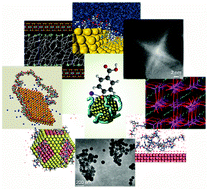Simulations of inorganic–bioorganic interfaces to discover new materials: insights, comparisons to experiment, challenges, and opportunities
Abstract
Natural and man-made materials often rely on functional interfaces between inorganic and organic compounds. Examples include skeletal tissues and biominerals, drug delivery systems, catalysts, sensors, separation media, energy conversion devices, and polymer nanocomposites. Current laboratory techniques are limited to monitor and manipulate assembly on the 1 to 100 nm scale, time-consuming, and costly. Computational methods have become increasingly reliable to understand materials assembly and performance. This review explores the merit of simulations in comparison to experiment at the 1 to 100 nm scale, including connections to smaller length scales of quantum mechanics and larger length scales of coarse-grain models. First, current simulation methods, advances in the understanding of chemical bonding, in the development of force fields, and in the development of chemically realistic models are described. Then, the recognition mechanisms of biomolecules on nanostructured metals, semimetals, oxides, phosphates, carbonates, sulfides, and other inorganic materials are explained, including extensive comparisons between modeling and laboratory measurements. Depending on the substrate, the role of soft epitaxial binding mechanisms, ion pairing, hydrogen bonds, hydrophobic interactions, and conformation effects is described. Applications of the knowledge from simulation to predict binding of ligands and drug molecules to the inorganic surfaces, crystal growth and shape development, catalyst performance, as well as electrical properties at interfaces are examined. The quality of estimates from molecular dynamics and Monte Carlo simulations is validated in comparison to measurements and design rules described where available. The review further describes applications of simulation methods to polymer composite materials, surface modification of nanofillers, and interfacial interactions in building materials. The complexity of functional multiphase materials creates opportunities to further develop accurate force fields, including reactive force fields, and chemically realistic surface models, to enable materials discovery at a million times lower computational cost compared to quantum mechanical methods. The impact of modeling and simulation could further be increased by the advancement of a uniform simulation platform for organic and inorganic compounds across the periodic table and new simulation methods to evaluate system performance in silico.

- This article is part of the themed collection: Bioinspired Surfaces and Materials

 Please wait while we load your content...
Please wait while we load your content...